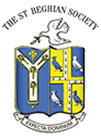|
 |
The Old St Beghian | |
| Jan 2018 | |||
Visit to Ypres - October 2017
Dacre Watson (SH 56-62)
A cold dank wind swept fitfully round me as I stood there; a cold front had moved through during the morning leaving the grass underfoot sodden, while a brightly feeble sun did nothing to warm me. I couldn’t help but think of those thousands of men who had fought over this very ground exactly 100 years ago during the third Battle of Ypres, which raged from June to November 1917. I would have a cold beer and a warm bed to go to later, those soldiers fighting where I stood would have considered it a successful day if they were still alive as night fell.
Lost in my thoughts, I became aware of someone standing beside me, it was our group leader and he asked me to join him in order to see the many tablets which form the rear wall of the largest British War Cemetery, Tyne Cot. We made our way over to this wall, 168 metres long, and it is on here that we find the names of thousands of men who fought and died in the Ypres salient and who have no known grave. The names are arranged by regiment and there are 34,888 names; in addition, there are a further 11,871 graves in this cemetery alone, and of these some 70% have not been identified. The sense of sacrifice by so many young men is difficult to appreciate fully.
Once we had reached the wall, my guide pointed out three names which had a familiar ring to them and I didn’t immediately remember where I had seen them before; and then it came to me, their names amongst so many others are carved on one of the wooden panels in the Foundation dining room. And so, as we approached the tablet listing the dead from the West Yorkshire Regiment, there was the name of 2 Lt. Philip Stott, who had been Head Boy at St Bees, killed on 25th April 1918 during what would have been the final German advance. A little further on was the tablet to the Lincolnshire Regiment and on it the name of Capt. D F Nielson DSO MC, while on a third tablet commemorating the Lancashire Fusiliers we found the name of Captain A P Hudson, killed during the third Battle of Ypres on 31st August 1917.
Entirely on his own initiative and knowing that I was deeply involved in St Bees School, our guide had brought a wreath which he then invited me to lay at the tablet to the West Yorkshires where 2 Lt. Stott is remembered. This I did.
I am not an emotional person by nature, but after I had laid that simple wreath I needed some time alone to pull myself together. The connection I felt with these three young men was extraordinary: we had played rugby on the same pitches, used the same classrooms, attended the same chapel and walked the same familiar grounds.
It was a deeply humbling experience, and trite as it may sound, I could only reflect on how lucky we have been as a generation not to be challenged as these three young men were.
Please click here to see photographs.
Home
The St Beghian Society
St Bees School,
St Bees, Cumbria, CA27 0DS.
Tel: (01946) 828093 Email: osb@stbeesschool.co.uk
Web: www.st-beghian-society.co.uk
![]()